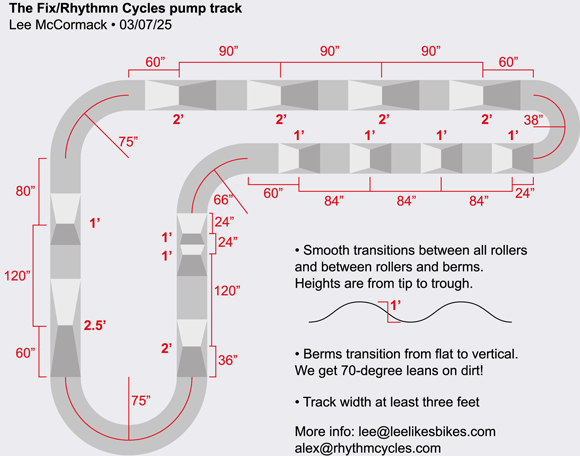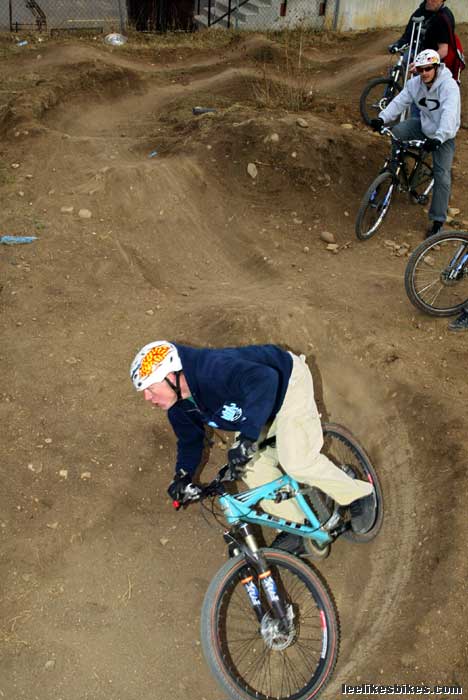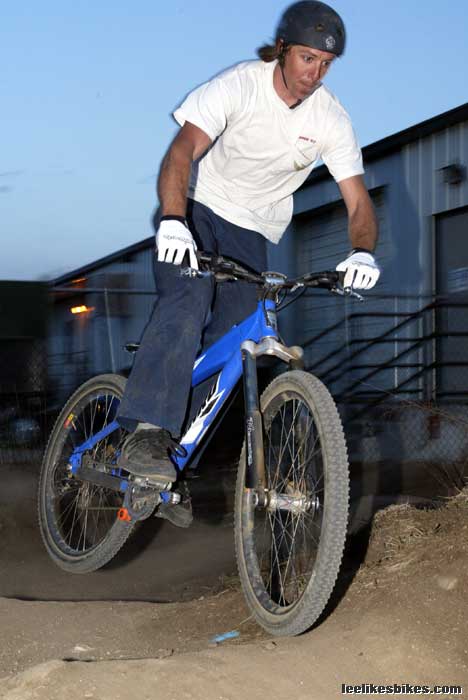How to build a pump track

|
Here’s a story I did for Decline magazine back in June. It includes detailed plans for the pump track at The Fix in Boulder, CO.
 Team Yeti’s Ross “The Crusher” Milan gets his pump on while Brian Lopes takes notes for future 4X encounters. |
For detailed info on building your own track, check out the hot ebook, Welcome to Pump Track Nation
— — —
Pump track mania is sweeping the globe. Mountain bikers everywhere are building endless loops of rollers and berms, and the riders are getting smoother, fitter and faster.
These mini tracks teach you to maintain speed — no, gain speed — over bumps and through tight corners. Almost anyone can ride a pump track. Beginners fumble, jumble and stumble, while experts manual, jump and rip. On pump tracks the speed, fear and risk are low, but the effort, fun and improvement are high.
Legend has it that Mick Hannah trained extensively on a pump track before he demolished the 2004 Sea Otter Classic. Knowing the fastest Aussies pump on a regular basis, pro downhiller Steve Wentz built a track at The Fix in Boulder, Colo. last fall. At first, his L-shaped loop was barely rideable, but within a week the lines were grooved and the riders were grooving.
When I posted a story and videos on this site, pump track reports poured in. The kids in Whistler, BC started building them. The guys at Riding High in Taichung, Taiwan built one. And Ray Petro of Ray’s MTB, the indoor bike park in Cincinnatti, made an awesome one out of wood. Pump tracks are superfun, and they’re good for you, so you might as well build one of your own.
Pick a spot. You can have plenty of fun in as little as 40 x 20 feet. Yes, that’s the size of your basement. More space means wider turns, bigger rollers and greater speeds. Flat land is best, but you can always rail some downhill berms then pump back uphill on a roller staircase. Oof.
Lay it out. Start with the turns. Make them tight enough to pump but not so tight you struggle to make them. A radius of about 75 inches works well. The 38-inch turn at The Fix creates champions but robs speed. Make sure your berms have constant arcs, and build them gradually from flat to vertical. When you get the hang of your track, you’ll be pulling almost three Gs and leaning 70 degrees.
 Learn how to build your own pump track |
Fill in the spaces. Build rollers or doubles between your turns. Avoid flat spots. Every square inch on your track should tilt upward, downward or sideways. No time for coasting!
Riding your pump track
 Ariel Lindsley: Maverick American’s XCer, marathoner, Super-D’er and pumper. |
Choose your weapon. Dirt jump hardtails and stiff dual suspension slalom bikes work well. A 24-inch cruiser with foot pegs and no brakes might be ideal.
Smoothness first, speed second. Charge into your pump track like a maniac, and you’ll injure a bystander. Start super slow, sucking up the front sides and pumping the backsides, and watch the speed build on its own.
Attack the berms. Dive into them like the sideways holes they are. Pump them for speed and get out of there!
Race! Mountain crossers should do three-lap time trials. Downhillers should keep it flowing for 10 laps. XC racers can keep rolling until the other guys kick them out. For head-to-butt fun, start two riders on opposite ends and let them pursue each other. The guy who gets caught loses. Switch directions. Rest. Repeat.
I hope this is helpful. In the near future I’ll show you the best ways to build rollers and berms. In the mean time, start designing!
— — —
For detailed info on building your own track, check out the hot ebook, Welcome to Pump Track Nation
This page has videos showing early sessions on The Fix’s pump track: http://leelikesbikes.com/Stories/010405

Comments are closed.